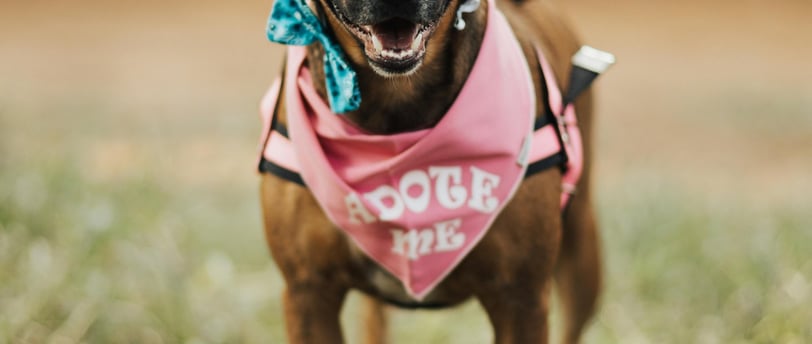How to Choose the Perfect Service Dog
Find out how to select the perfect service dog for your needs. This guide covers important traits, how to conduct a temperament test, and where to find service dogs, whether through adoption or specialized facilities.
BEGINNER BASICS
Crysta Germany
8/11/202411 min read


Finding the Right Partner
Choosing the perfect service dog is a decision that requires careful consideration and planning. No matter what disability you may have, the right service dog can significantly enhance your quality of life. This guide will walk you through the essential factors to consider, from understanding your specific needs to making the final decision on your canine companion.
1. Understanding Your Needs
The first step in selecting a service dog is to assess your specific disability and the tasks the dog will need to perform. Different disabilities generally require different types of service dogs. For instance, individuals needing mobility support require a larger dog capable of bearing weight, while those needing medical alert or allergy detection dogs should prioritize breeds with an exceptional sense of smell. Psychiatric service dogs, on the other hand, must be friendly and social, forming a close bond with their handler. A service dog can be chosen based on their size, breed, or personality- it all depends on what is best for you.
2. Where to Find Service Dogs
Finding the right service dog involves choosing between adoption and specialized facilities. Each option has its benefits and considerations, so it’s important to evaluate which best fits your needs, values, and circumstances.
Adoption: Adopting a service dog from a local shelter or rescue organization can be a rewarding experience, giving a dog in need a new home while also potentially saving a life. This route often involves training the dog yourself, which can strengthen the bond between you and your companion. However, it requires a commitment of time and effort. You may need to work with a professional trainer to help the dog develop the skills necessary for service work. Adoption provides a chance to assess a dog’s temperament and work closely with them to build their abilities.
Specialized Facilities: Service dog facilities are specialized organizations that train and sometimes breed dogs specifically for service roles. These facilities select dogs based on traits essential for service work and often provide pre-trained dogs that are matched to your needs. This option can save time and offer a higher degree of initial support. However, it may come with higher costs and less flexibility in choosing a dog. Facilities also provide ongoing support and resources, which can be greatly beneficial for new handlers.
3. The Importance of Personality
Selecting a service dog involves more than just finding a breed that suits your needs; it’s crucial to assess the dog’s personality to ensure its suitable for service work. A dog’s temperament can significantly impact its effectiveness and your overall experience, so evaluating its traits is essential. Look for a dog that is calm, friendly, and non-aggressive. While shyness or slight aggression can often be managed with patience and training, a dog with a stable and approachable demeanor will generally be easier to work with. Socializing your dog with various people, other dogs, and even cats can also enhance its adaptability and effectiveness as a service animal.
To assess a dog’s temperament, conducting a temperament test is highly recommended. Start by observing how the dog interacts with other dogs and people. Next, spend about 30 to 60 minutes with the dog in a quiet, calm environment to allow it to relax and become comfortable with you. During this time, engage in activities such as playing with and feeding the dog to evaluate its behavior towards possessions and food. Additionally, calling the dog’s name and observing its reaction can provide insights into its responsiveness and willingness to bond. A positive reaction, even if tentative, can be a good indicator of a dog’s potential for service work.
4. Breed Considerations
While there are no limitations on the breeds that can become service dogs, some breeds are better suited for specific tasks. Common service dog breeds include Golden Retrievers, Labrador Retrievers, German Shepherds, and Poodles, all known for their intelligence, trainability, and temperament. However, legally, any breed can be a service dog. The key is to choose a breed that fits your disability and lifestyle. For instance, highly active individuals might prefer a breed like a Border Collie, known for its energy and enthusiasm, while those seeking a calmer companion might opt for a Golden Retriever. Consider the pros and cons of different breeds, and choose one that matches your activity level, living space, and daily routine.
5. Size Matters
The size of your service dog is an important consideration, particularly when it comes to the tasks they will perform. For example, dogs used for mobility support need to be large and sturdy enough to bear weight and assist with balance. Conversely, service dogs for tasks like psychiatric support or allergy detection can be smaller. Additionally, your size as the handler is a factor; taller individuals may require larger dogs, while smaller handlers might do better with a more compact dog. Beyond task-specific needs, consider the practical aspects of living with a large or small dog, such as your living space, transportation options, and your ability to handle the dog physically.
6. Training Potential
A service dog's success largely depends on its trainability. The ideal dog is one that is eager to learn, intelligent, and not overly stubborn. To evaluate a dog's training potential, observe its behavior, learning style, and energy levels. High-energy breeds like Border Collies and German Shepherds are often quick learners, while calmer breeds may be more receptive to consistent training. A dog's natural ability, combined with effective training, creates a successful service dog. Early socialization, positive reinforcement, and a structured environment are all crucial elements that contribute to a dog's trainability.
7. Health and Longevity
When selecting a service dog, it’s important to consider the dog’s health and expected lifespan. A healthy dog with a full life ahead is crucial, as a sick or aging dog may struggle to meet the demands of service work. Service dogs typically work for 8-10 years before retiring, depending on their health and the age at which they started working. To ensure you're choosing a healthy dog, always consult with a veterinarian, review the dog’s medical records, and inquire about the shelters or facility’s health policies. Keeping your service dog healthy is your responsibility, as they will rely on you for care and support throughout their life just as much as you rely on them.
8. Lifestyle Compatibility
Your lifestyle plays a significant role in determining the right service dog for you. Consider whether you have the space at home for a large, active dog or if a smaller, more laid-back dog would be a better fit. Assess your daily routine—do you have time to care for a dog? Are you frequently in crowded areas that might be challenging for a service dog? Your activity level is also important; if you enjoy hiking and outdoor activities, a high-energy dog might be ideal, while a more relaxed lifestyle might suit a lower-energy breed. Additionally, consider your home environment—do you have enough space for the dog to move around comfortably? These factors are crucial in ensuring that your service dog can integrate smoothly into your life.
9. Making the Final Decision
Before making your final decision, consult with a professional dog trainer or veterinarian. Their expertise can provide valuable insights and help you make an informed choice. If possible, consider a trial period with the dog to ensure that you are a good match. This time allows you to observe how well the dog adapts to and fits with your lifestyle and whether you feel confident in your ability to work together. Trust your instincts and be patient—finding the right service dog is a process, and if one dog isn’t the perfect fit, there will always be another opportunity.
Ensuring a Successful Partnership
Choosing the right service dog involves careful consideration of your needs, the dog’s personality, and where to find your future companion. By understanding what traits are crucial, conducting a thorough temperament test, and exploring both adoption and specialized facilities, you can ensure a successful match. Remember, a well-chosen service dog can significantly improve your daily life and provide invaluable support. Take your time, trust your instincts, and seek professional advice if needed to find the perfect service dog for you.
photo credit: Matheus Bertelli, Mikhail Nilov on pexels, ylanite, ZigmarsBerzins on pixabay






Finding the Right Partner
Choosing the perfect service dog is a decision that requires careful consideration and planning. No matter what disability you may have, the right service dog can significantly enhance your quality of life. This guide will walk you through the essential factors to consider, from understanding your specific needs to making the final decision on your canine companion.
1. Understanding Your Needs
The first step in selecting a service dog is to assess your specific disability and the tasks the dog will need to perform. Different disabilities generally require different types of service dogs. For instance, individuals needing mobility support require a larger dog capable of bearing weight, while those needing medical alert or allergy detection dogs should prioritize breeds with an exceptional sense of smell. Psychiatric service dogs, on the other hand, must be friendly and social, forming a close bond with their handler. A service dog can be chosen based on their size, breed, or personality- it all depends on what is best for you.
2. Where to Find Service Dogs
Finding the right service dog involves choosing between adoption and specialized facilities. Each option has its benefits and considerations, so it’s important to evaluate which best fits your needs, values, and circumstances.
Adoption: Adopting a service dog from a local shelter or rescue organization can be a rewarding experience, giving a dog in need a new home while also potentially saving a life. This route often involves training the dog yourself, which can strengthen the bond between you and your companion. However, it requires a commitment of time and effort. You may need to work with a professional trainer to help the dog develop the skills necessary for service work. Adoption provides a chance to assess a dog’s temperament and work closely with them to build their abilities.
Specialized Facilities: Service dog facilities are specialized organizations that train and sometimes breed dogs specifically for service roles. These facilities select dogs based on traits essential for service work and often provide pre-trained dogs that are matched to your needs. This option can save time and offer a higher degree of initial support. However, it may come with higher costs and less flexibility in choosing a dog. Facilities also provide ongoing support and resources, which can be greatly beneficial for new handlers.
3. The Importance of Personality
Selecting a service dog involves more than just finding a breed that suits your needs; it’s crucial to assess the dog’s personality to ensure it’s suitable for service work. A dog’s temperament can significantly impact its effectiveness and your overall experience, so evaluating its traits is essential. Look for a dog that is calm, friendly, and non-aggressive. While shyness or slight aggression can often be managed with patience and training, a dog with a stable and approachable demeanor will generally be easier to work with. Socializing your dog with various people, other dogs, and even cats can also enhance its adaptability and effectiveness as a service animal.
To assess a dog’s temperament, conducting a temperament test is highly recommended. Start by observing how the dog interacts with other dogs and people. Next, spend about 30 to 60 minutes with the dog in a quiet, calm environment to allow it to relax and become comfortable with you. During this time, engage in activities such as playing with and feeding the dog to evaluate its behavior towards possessions and food. Additionally, calling the dog’s name and observing its reaction can provide insights into its responsiveness and willingness to bond. A positive reaction, even if tentative, can be a good indicator of a dog’s potential for service work.
4. Breed Considerations
While there are no limitations on the breeds that can become service dogs, some breeds are better suited for specific tasks. Common service dog breeds include Golden Retrievers, Labrador Retrievers, German Shepherds, and Poodles, all known for their intelligence, trainability, and temperament. However, legally, any breed can be a service dog. The key is to choose a breed that fits your disability and lifestyle. For instance, highly active individuals might prefer a breed like a Border Collie, known for its energy and enthusiasm, while those seeking a calmer companion might opt for a Golden Retriever. Consider the pros and cons of different breeds, and choose one that matches your activity level, living space, and daily routine.
5. Size Matters
The size of your service dog is an important consideration, particularly when it comes to the tasks they will perform. For example, dogs used for mobility support need to be large and sturdy enough to bear weight and assist with balance. Conversely, service dogs for tasks like psychiatric support or allergy detection can be smaller. Additionally, your size as the handler is a factor; taller individuals may require larger dogs, while smaller handlers might do better with a more compact dog. Beyond task-specific needs, consider the practical aspects of living with a large or small dog, such as your living space, transportation options, and your ability to handle the dog physically.
6. Training Potential
A service dog's success largely depends on its trainability. The ideal dog is one that is eager to learn, intelligent, and not overly stubborn. To evaluate a dog's training potential, observe its behavior, learning style, and energy levels. High-energy breeds like Border Collies and German Shepherds are often quick learners, while calmer breeds may be more receptive to consistent training. A dog's natural ability, combined with effective training, creates a successful service dog. Early socialization, positive reinforcement, and a structured environment are all crucial elements that contribute to a dog's trainability.
7. Health and Longevity
When selecting a service dog, it’s important to consider the dog’s health and expected lifespan. A healthy dog with a full life ahead is crucial, as a sick or aging dog may struggle to meet the demands of service work. Service dogs typically work for 8-10 years before retiring, depending on their health and the age at which they started working. To ensure you're choosing a healthy dog, always consult with a veterinarian, review the dog’s medical records, and inquire about the shelters or facility’s health policies. Keeping your service dog healthy is your responsibility, as they will rely on you for care and support throughout their life just as much as you rely on them.
8. Lifestyle Compatibility
Your lifestyle plays a significant role in determining the right service dog for you. Consider whether you have the space at home for a large, active dog or if a smaller, more laid-back dog would be a better fit. Assess your daily routine—do you have time to care for a dog? Are you frequently in crowded areas that might be challenging for a service dog? Your activity level is also important; if you enjoy hiking and outdoor activities, a high-energy dog might be ideal, while a more relaxed lifestyle might suit a lower-energy breed. Additionally, consider your home environment—do you have enough space for the dog to move around comfortably? These factors are crucial in ensuring that your service dog can integrate smoothly into your life.
9. Making the Final Decision
Before making your final decision, consult with a professional dog trainer or veterinarian. Their expertise can provide valuable insights and help you make an informed choice. If possible, consider a trial period with the dog to ensure that you are a good match. This time allows you to observe how well the dog adapts to and fits with your lifestyle and whether you feel confident in your ability to work together. Trust your instincts and be patient—finding the right service dog is a process, and if one dog isn’t the perfect fit, there will always be another opportunity.
Ensuring a Successful Partnership
Choosing the right service dog involves careful consideration of your needs, the dog’s personality, and where to find your future companion. By understanding what traits are crucial, conducting a thorough temperament test, and exploring both adoption and specialized facilities, you can ensure a successful match. Remember, a well-chosen service dog can significantly improve your daily life and provide invaluable support. Take your time, trust your instincts, and seek professional advice if needed to find the perfect service dog for you.
photo credit: Matheus Bertelli, Mikhail Nilov on pexels, ylanite, ZigmarsBerzins on pixabay






